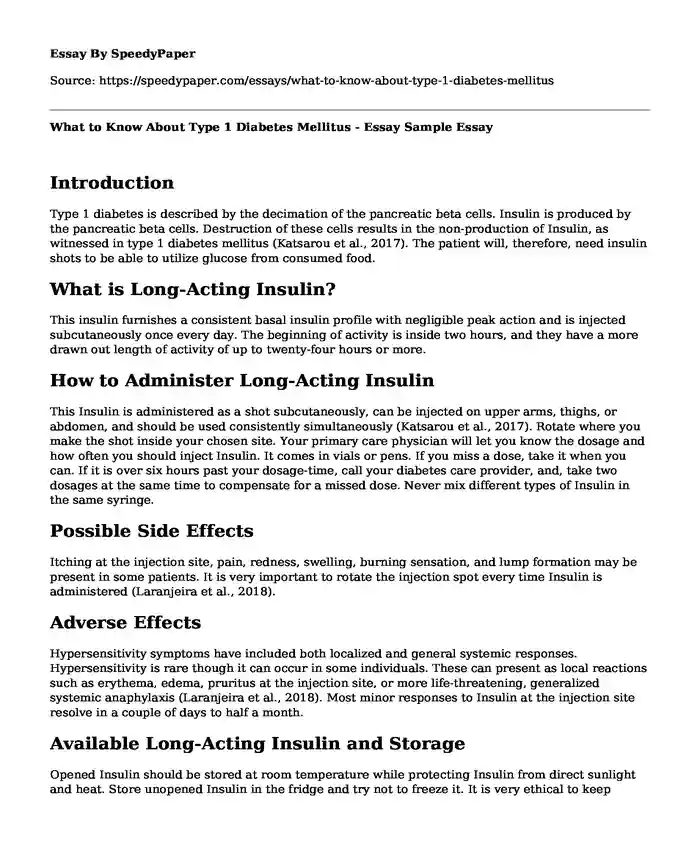
| Type of paper: | Essay |
| Categories: | Medicine Healthcare Diabetes |
| Pages: | 3 |
| Wordcount: | 649 words |
Introduction
Type 1 diabetes is described by the decimation of the pancreatic beta cells. Insulin is produced by the pancreatic beta cells. Destruction of these cells results in the non-production of Insulin, as witnessed in type 1 diabetes mellitus (Katsarou et al., 2017). The patient will, therefore, need insulin shots to be able to utilize glucose from consumed food.
What is Long-Acting Insulin?
This insulin furnishes a consistent basal insulin profile with negligible peak action and is injected subcutaneously once every day. The beginning of activity is inside two hours, and they have a more drawn out length of activity of up to twenty-four hours or more.
How to Administer Long-Acting Insulin
This Insulin is administered as a shot subcutaneously, can be injected on upper arms, thighs, or abdomen, and should be used consistently simultaneously (Katsarou et al., 2017). Rotate where you make the shot inside your chosen site. Your primary care physician will let you know the dosage and how often you should inject Insulin. It comes in vials or pens. If you miss a dose, take it when you can. If it is over six hours past your dosage-time, call your diabetes care provider, and, take two dosages at the same time to compensate for a missed dose. Never mix different types of Insulin in the same syringe.
Possible Side Effects
Itching at the injection site, pain, redness, swelling, burning sensation, and lump formation may be present in some patients. It is very important to rotate the injection spot every time Insulin is administered (Laranjeira et al., 2018).
Adverse Effects
Hypersensitivity symptoms have included both localized and general systemic responses. Hypersensitivity is rare though it can occur in some individuals. These can present as local reactions such as erythema, edema, pruritus at the injection site, or more life-threatening, generalized systemic anaphylaxis (Laranjeira et al., 2018). Most minor responses to Insulin at the injection site resolve in a couple of days to half a month.
Available Long-Acting Insulin and Storage
Opened Insulin should be stored at room temperature while protecting Insulin from direct sunlight and heat. Store unopened Insulin in the fridge and try not to freeze it. It is very ethical to keep medication out of the range of children also, pets alike.
Long-acting insulin Viability at room temperature Onset of action Duration of action
Lantus U-100 28 days 1-2 hours 24 hours
Toujeno U-300 42 days 6 hours 24-36 hours
Levemir Detemir 42 days 1-2 hours 24 hours
Basaglar U-100 28 days 1-2 hours 24 hours
Tresiba U-200 56 days 1-4 hours 42 hours
When to Consult a Diabetic Healthcare Provider
Regular high and low blood sugar
Feeling debilitated, nausea and spewing
Flu-like side effects for example, any indication of a hypersensitive response, hives or pruritus, difficulty in breathing or wheezing, facial edema, and peripheral edema.
What to Know While On Insulin Therapy
Before taking this medication, inform your primary physician about other medications you are currently taking, including OTC meds and herbal medicines, presence of Liver or Kidney disease. There is a need to share about pregnancy and plans for pregnancy and breastfeeding. Continuously carry some starch as this will help avoid blood sugar going low. Your insulin dose may need to change when you are sick or at the point when you change your eating regimen or activity. Alcohol intake may cause indications that vibe like low blood glucose. Check your blood glucose regularly when drinking liquor. Do not change brands of Insulin without consulting your primary care physician.
References
Katsarou, A., Gudbjörnsdottir, S., Rawshani, A., Dabelea, D., Bonifacio, E., Anderson, B. J., & Lernmark, Å. (2017). Type 1 diabetes mellitus. Nature reviews Disease primers, 3(1), 1-17. https://www.nature.com/articles/nrdp201716
Laranjeira, F. O., de Andrade, K. R., Figueiredo, A. C., Silva, E. N., & Pereira, M. G. (2018). Long-acting insulin analogues for type 1 diabetes: An overview of systematic reviews and meta-analysis of randomized controlled trials. PloS one, 13(4), e0194801. https://journals.plos.org/plosone/article?id=10.1371/journal.pone.0194801
Cite this page
What to Know About Type 1 Diabetes Mellitus - Essay Sample. (2023, Dec 16). Retrieved from https://speedypaper.com/essays/what-to-know-about-type-1-diabetes-mellitus
Request Removal
If you are the original author of this essay and no longer wish to have it published on the SpeedyPaper website, please click below to request its removal:
- Free Essay on Hospital Discharge Teaching
- Essay Example about Germany's Healthcare
- Essay Example Dedicated to Counseling on Alcohol Addiction
- Essay Example about the Social Security Income Program
- Essay Sample on Importance of Screening for Cigarette Smoking
- Essay Sample on Human Diseases by System: Skeletal and Muscular
- The Great Contraception Debate - Essay Sample
Popular categories




